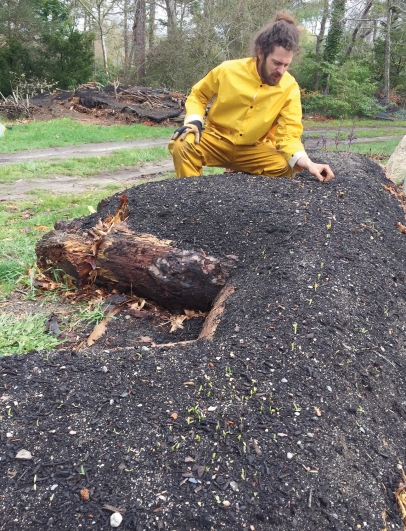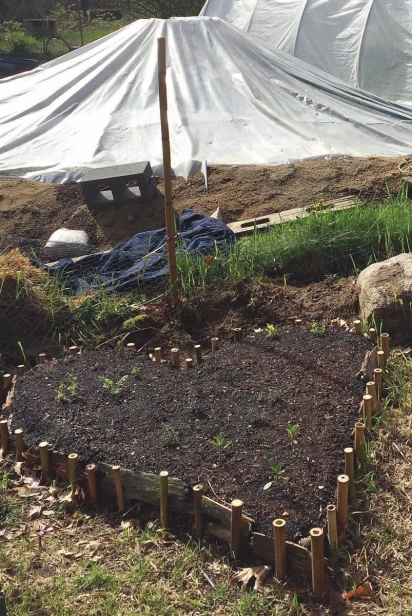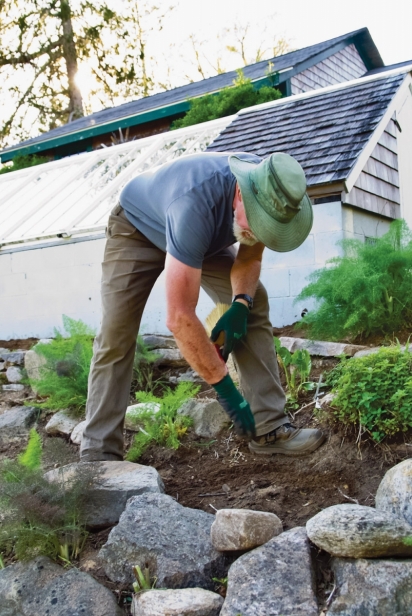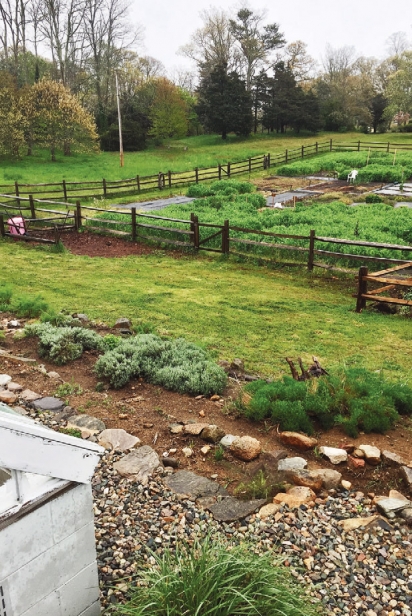Mounding Evidence
Hugelkultur Gains Ground
Hugelkultur, pronounced hoo-gul-culture, translates to hill or mound culture. Practiced in Germany and Eastern Europe for hundreds of years, rotting wood is placed on the surface of the ground or into a cavity perhaps a foot or two deep as the first layer of a planting bed. Natural farmer Masanoba Fukuoka practiced the method and permaculturist Sepp Holzer is considered a hugelkultur master.
In a typical hugelbeet, or garden bed, the tree trunk or log layer is followed by smaller branches and sticks, leaves and other yard waste including sections of turf flipped root side up, and then soil, compost, and mulch. As they decompose, the nutrients released
Small creatures like worms and microbes do the heavy lifting. Drawn to the wood and other biomass, they help with its decomposition, digesting the decaying plant matter and leaving its nutrients in the soil in forms far more accessible to plants and tree roots. By channeling through the soil, worms also aerate it, providing a lighter tilth for seeds to germinate in, seedlings to emerge from, and for roots to push through to reach the moisture they need.
A bonus is the worm castings or excrement. Able to absorb many times its weight in moisture, worm waste is a valuable component of drought-proofing the hugelbeets. Importantly, the carbon present in the wood and other debris is effectively sequestered or isolated underground within the living soil created by the process.
Whether creating dynamic vegetable beds to extend the growing season or channeling rainwater to best serve the environment, two Cape Cod men focus on the many different aspects of hugelkultur.
Local hugelkultur practitioner Matt Milan of Brewster’s Phoenix Farm raises food because it’s what he loves. He grins as he describes living in DC as a student, when he and a gang of local farmer friends grew veggies on vacant apartment roofs.
Now he grows produce on the Cape. Exploring the land that Milan farms is not for the timid. No straight rows here; his aesthetic favors curving lines. The growing beds, terraces and mounds are dynamic and eclectic. One bed he’s creating swirls and curls, mimicking the perimeter of an existing fence he fancies, its path meandering around the property.
Personal, too, are his planting designs. Some crops, like garlic, are plunked into place in perfect sequence, evenly spaced in exacting rows. Others, like arugula, is seeded intensely en masse, its rippled leaves waving in the breeze. Even in very early spring Phoenix Farm is greened up and looking good.
Centuries ago in Paris and London, manure added under the market gardens warmed the soil to the point that, with bell-shaped glass cloches placed over the plants each evening, farmers were able to grow enough produce for those cities well past their traditional growing seasons. Milan, too, sometimes adds a layer of manure over the log base and well under the soil’s surface where he grows the produce.
The decomposing wood buried within his hugelbeets retains the moisture that will be available to plant roots above or nearby while it creates healthy soil. The added manure fosters aerobic decomposition to produce heat, effectively warming the soil. Milan says, “It’s truly extended my ability to grow crops a good month longer into the fall.”
One measure of a hugelbeet’s effectiveness is the build. The best ones are constructed with care, nestling logs against one another tightly so that little space is left empty. As the wood decomposes, some shifting occurs and a bit of annual maintenance is needed to keep it in check. “Look for the gaps and shove in all types of woody matter,” Milan says. “I see it as playing reverse Jenga.”
Encouraging everyone to give it a go, Milan points to a small hugelbeet containing herbs. Formed in the shape of a heart, it flanks the main entrance to his growing areas. He smiles while sharing his recipe for this example of a DIY hugelbeet for novices. “Lay down a few layers of corrugated cardboard on a modest-sized flat area in your yard, top it with wood chips and follow with grass clippings, twigs, leaves, soil, compost and a bit of mulch, and then plant right into it.” Milan laughs, “It’s a diet hugel.”
Drawn to gardening videos during Covid’s start, this writer discovered two different YouTube home gardeners, one in Australia and one in Nova Scotia, each burying wood and debris to fill raised beds. Now knowing the concept’s name, and curious to experience hugelkultur firsthand, I dug in, thinking even if it yielded nothing more than exercise, it was a win.
Whittling away each evening in April 2020, I excavated an eight-foot square pit, 30 inches deep. First fitting in a treasure trove of half-decomposed logs from an old woodpile, I piled in layers of sticks, twigs, leaves, the original soil and then a final good four inches of well-rotted compost. Cutting eight organic potatoes into sections each containing an eye, I tucked the pieces into the soil after they cured, hoping for the best.
Several months later after virtually no watering, the plants were tall and lush. They had long crowded out and forced the move of a row of strawberries. Wondering if the relentless chipmunks and voles had found them first, I unearthed the tubers. I could’ve let them grow a bit larger, yet I bagged a sack full of lovely Yukon golds to share with friends and family. Not bad for a first time hugelbeet spud grower.
Regenerative agroecologist Peter Jensen is presently back in his Orleans home after time abroad spent consulting as Terra Firma International. He and his wife Lynn Van Norman collaborate with NGOs (non-governmental organizations) on nearly every continent to teach communities how to protect aquifers and strengthen their food security. They share the skills of controlling water in fragile environments, growing food organically and using simple hand tools, all while providing nutritional education. While here on the Cape, the couple is now working as Terra Firma Permagardens. Many projects underway include work at an Airbnb in their hometown, a residence in Cautumet and a demonstration keyhole garden in Falmouth. Named after an old-fashioned skeleton key lock, keyhole gardens are a type of permaculture that allows easy access to the center of a raised bed for the gardener.
Jensen reflects on how climate is undeniably changing around the globe. “The Cape’s is becoming one of cool moist winters and hot dry summers; still maritime, but more Mediterranean,” he says. “When we can help prepare people and the landscape for climate then we can all worry less about the weather.”
Whether on a UN project, or volunteering as he presently is at Sea Call Farm, his town’s community garden, Jensen’s process begins with a detective-like analysis of rainwater flow. “It’s all about the water,” says Peter. “The beauty of it is that we can capture moisture from September through May, and push it deep into the subsoil, where it will be available in the summer months for plant and tree roots to access.”
At one residential project, Jensen will corral and then direct roof runoff to several planting areas as well as carve a gravel-lined stairway into the hillside to access a second floor apartment. Onsite, he explains the lingo. First, determine the places where the precipitation runs most forcefully, like an exposed downspout; these are the point sources. Using sound effect words of his own creation like “Theddlelump!” and “Pshooht!” he describes the water’s sound and motion as it jettisons off the roof in a storm event.
Jensen skips up the slope to a hollowed-out pathway. Later it will be filled with gravel, becoming what Jensen refers to as a lithic swale. Carved into the hill and just wide enough to walk on, he points to several deeper holes throughout its length. There are the keyholes; areas where a much greater volume of water can accumulate than in the trough-like paths. Jensen will let the water rush in and collect in these, slowing it down so that he can point it to where he wants it to go.
The now more gently flowing water in the swales deposits some of its volume as it travels along. “The fast-moving runoff,” says Jensen, “has become a water walk, where it can slowly sink and spread. Instead of losing it, we can use it.”
Jensen’s hybrid design, a cross between an excavated hugel pit and an aboveground mound, is what he calls a hugelterrace. Hugging the slope, its narrow gravel-lined channels hydrate the berms, the built-up growing spaces on the adjacent downhill side. Beneath the soil in the berms, on alternate tiers from the swales, Jensen buries logs, twigs, sticks, and leaves, topped by several inches of good quality soil.
Landscapes may be distinctly patterned with equidistant swales and berms. Others flow more irregularly to be in sync with, for example, a property’s more irregular elevations, existing plantings, and/or overall design preferences. “Van Norman,” Jensen says, “is the plant person. Once I’ve laid out the structure, she takes it all in to visualize the design and lays out the plantings wonderfully using native species as much as possible.”
Beneath the plantings, within the berms, in the deepest areas under the logs, the rainwater pools and is absorbed by the logs and other biomass. “The cold decomposition of the wood fosters the creation or expansion of a fungal network,” says Jensen. “Fungal mycelial networks are effective bio-filters that are capable of mycoremediation or detoxing the water that passes through it. Imagine if we could use this methodology in our towns as an option to purify the rainwater gushing off our roadways of environmental contaminants before it enters our aquifer.”
Whether in a sub-Saharan refugee camp or literally in his own backyard, for Jensen the challenge is in strengthening the ecosystem. Part plumber, part shaper of the land, he’s found a magical balance drawing on principles used hundreds of years ago by many cultures. Terra Firma’s involvement worldwide has shown how these techniques create positive change. By channeling the rain that one does receive and by using methods like keyholes and hugelterraces, healthy soil is created. This soil will hold water and help to grow healthy plants that will feed children and communities.
Jensen says, “We harness the power of the logs.”
Matt Milan
Phoenix Farm: 246 Harwich Road, Brewster
Self-serve roadside stand open daily
Farmers’ Markets – Brewster, Orleans, Provincetown and Wellfleet
Peter Jensen, Lynn Van Norman
Terra Firma Permagardens – Instagram, 774-722-9514 (texts preferred)
Terra Firma International – ThisIsTerraFirma.com, Youtube – Terra Firma International










